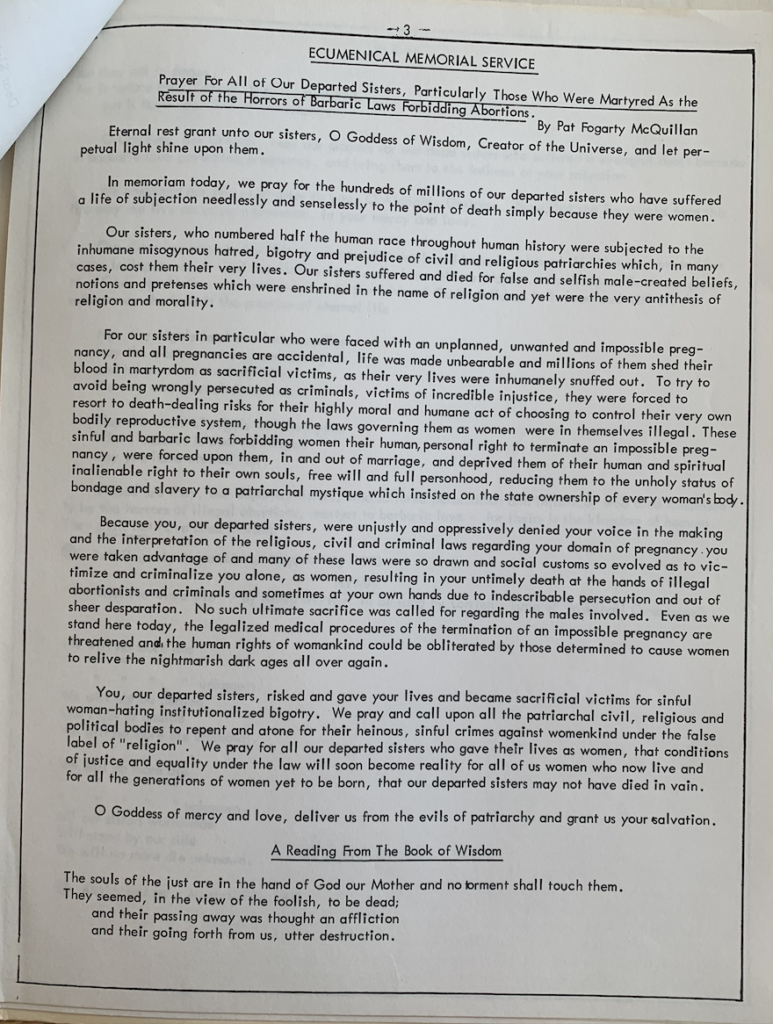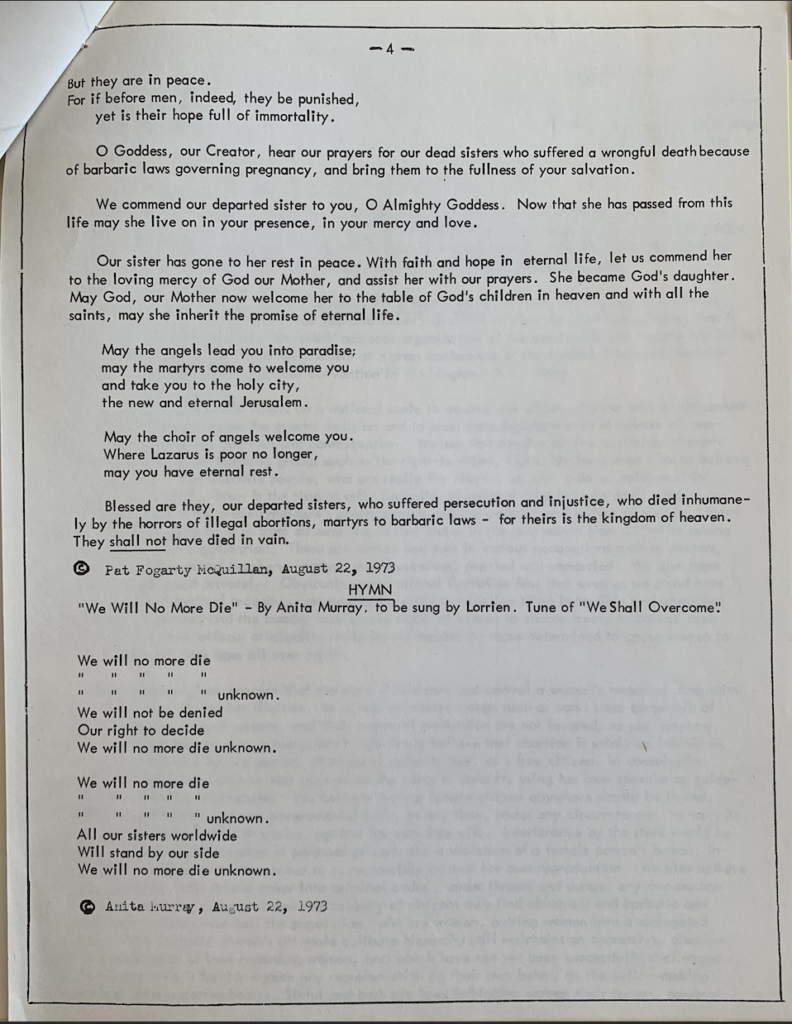The Catholic view of reproductive healthcare seems obvious.
The Church vehemently opposes legal abortion, and has contributed immensely to the pro-life movement since Roe v. Wade was decided in 1973. Many individual Catholics built widespread efforts to limit reproductive rights throughout the late 1900s and early 2000s, ranging from political lobbying to mass media campaigns.1 These strategies eventually succeeded in 2022, when the Supreme Court’s decision in Dobbs v. Jackson Women’s Health Center overturned Roe and placed the health and safety of countless individuals at risk.
This history, and our current political environment, makes the idea of feminist, pro-choice Catholicism seem impossible.
But for members of Catholics for Choice (CFC; formerly Catholics for a Free Choice), a commitment to reproductive justice goes hand-in-hand with religious faith.
Origins
CFC was organized at the national level in 1973 by Catholic feminist Patricia Fogarty McQuillan and several fellow activists. McQuillan was motivated by many American Catholic bishops’ hostile condemnations of the Roe decision. She feared that this anti-abortion sentiment would endanger access to reproductive healthcare across the country.2
CFC worked to fight the Religious Right by proving that many Catholics were, in fact, fiercely pro-choice. They argued that these individuals held their progressive opinions not in spite of, but because of their religious faith and its values.
Building a Pro-Choice Majority
In the late twentieth century, CFC became the flagship organization of the pro-choice Catholic movement.
As they expanded, they established themselves as leaders among religious progressives working for reproductive justice.
They weren’t alone in their work. In the United States, both Christian and non-Christian religious groups embarked on faith-based lobbying efforts to protect reproductive healthcare.3 Each worked to raise awareness about the growing number of pro-choice religious Americans. So, CFC’s work offers insight into a broader political movement.

After Roe v. Wade, the abortion debate became increasingly polarized and even more hostile than it had been before. The decision marked a turning point in the clash for both reproductive justice advocates and opponents. Afterwards, anti-abortion groups dramatized their arguments and focused on new issues, like a religious view of fetal development.4 As a result, activists seeking to protect abortion access had to embrace new techniques to prove that this healthcare was widely supported.
CFC used their public work to establish that, contrary to the Religious Right’s arguments, Catholic Americans had varied opinions on reproductive rights. Many Catholics, in fact, strongly supported safe and legal abortion access.
Does the data above challenge your understanding of Catholics’ political attitudes or social values? How so?
Jesus the Feminist
For CFC, faith was rooted in social equality.
They firmly rejected the Catholic Church’s patriarchal hierarchy, and advocated for the elevation of women’s voices within religious debates.

In this letter, McQuillan offered an inherently radical depiction of Jesus. By using biblical evidence to challenge the Catholic Church, this text explicitly refuted the Religious Right’s arguments that Christian teachings promote conservative social values or behaviors. Her case for women’s equality drew on feminist theology, and an alternative reading of the Gospel. In this worldview, Catholicism is a progressive faith.
“Jesus chose women as apostles and disciples and treated women on an equal basis with men, spiritually, intellectually and humanly, contrary to the oppressive religious and civil laws of his time.”
Patricia McQuillan
This was a viewpoint held by many individuals, as Catholic women developed a broad feminist network throughout the second half of the twentieth century. For these various activists and groups, Catholic faith was a central part of their feminism.5 Only part of the broader Catholic feminist movement focused on abortion access, but the use of religion to support a progressive political goal was a widespread tactic used by many activists.
In what contexts might faith benefit activism? When might it be unhelpful?
A Pope and the Public
Unsurprisingly, CFC’s view of religion was controversial. But, this was intentional and helped them work towards their goals. The non-profit organized many public demonstrations to generate debate and raise awareness about abortion access.
In 1974, they held an event at St. Patrick’s Cathedral in New York City to declare Patricia McQuillan the first female pope. During this inauguration, McQuillan delivered a speech that condemned the Church’s stance on abortion as nothing more than a political method of maintaining women’s oppression. The institution’s view, she argued, was completely disconnected from authentic religion.

This event directly challenged the Church’s patriarchal hierarchy and publicly established an alternative, progressive vision of faith. For CFC, social justice and the active pursuit of equal rights is a central part of a religious life.
McQuillan’s demonstration attracted a huge amount of publicity — both positive and negative. Despite the criticism, this coverage spread the organization’s message to a wide public audience.6 It allowed her to effectively counter the Religious Right’s efforts to dominate the public narrative, and advocate for reform in the Church.
What might CFC’s actions teach us about how we can challenge oppressive institutions?
A Progressive God(dess)
Challenging conservative Catholicism also meant redefining the very notion of God.
As part of their rejection of the Church’s patriarchy, CFC dismissed the notion of an explicitly male holy figure. Instead, several of their public materials refer to a female or female-aligned divinity.

“She became God’s daughter. May God, our Mother now welcome her to the table of God’s children in heaven and with all the saints, may she inherit the promise of eternal life.”
Patricia McQuillan

In 1973, Patricia McQuillan and other members of CFC participated in a demonstration funeral held by the National Organization of Women to mourn individuals who had died from illegal abortions. This event protested the tragedies caused by a lack of accessible reproductive healthcare. McQuillan’s contributions to the service offer a vision of a feminine Christian Goddess that cares for victims of oppression and challenges conservative hatred.
Catholics for Choice created a radically progressive interpretation of religion, which completely transformed what their Catholic identity meant to them. By redefining this faith as a tool for liberation, CFC built a religion that can be used as a driving force for social justice.
Do you think CFC’s vision of religion has value in our polarized society? Should we incorporate their strategies or ideas into modern activism?
Further Reading:
Patricia Miller, Good Catholics: The Battle Over Abortion in the Catholic Church. University of California Press, 2014.
In this book, Miller outlines the history of the long conflict between pro-choice Catholics and the patriarchal hierarchy of the Church that opposed them. She surveys the early work of Catholics for Choice, and explores how the organization fits into the larger religious reproductive justice movement. The book also discusses CFC’s religious beliefs, and their application of Catholic feminism to the abortion rights movement.
Mary J. Henold, Catholic and Feminist: The Surprising History of the American Catholic Feminist Movement. University of North Carolina Press, 2012.
Henold traces the development of Catholic feminism from the 1960s to the ‘80s. It provides more information on the relationship between their faith and progressive ideas, and how they built a feminist theology. The book offers valuable insight into the cultural and political debates within the Church, and how they related to broader social tensions.
Johanna Schoen, Abortion After Roe. University of North Carolina Press, 2015.
This book discusses the aftermath of Roe v. Wade, and the transformation of the abortion debate after the Supreme Court ruling. It explores the evolution of both the pro-choice and anti-abortion movements, and offers details about the reality of working towards reproductive justice in the late twentieth century. Schoen provides helpful context for CFC’s activism.
Additional Resources:
- Explore the organization’s past work through the Catholics for Choice records in the Sophia Smith Collection of Women’s History at Smith College.
- Listen to a student-made podcast about Catholics for Choice’s history.
- View CFC’s website, and their current opportunities for getting involved in the fight to protect reproductive rights.
Works cited
Header: CFC members and other pro-choice Catholics protesting Pope John Paul II’s anti-abortion policy, 1987. Catholics for Choice records, Sophia Smith Collection.
- Elizabeth Dias and Lisa Lerer, The Fall of Roe: The Rise of a New America (Flatiron Books, 2024), 45. ↩︎
- Patricia Miller, Good Catholics: The Battle Over Abortion in the Catholic Church (University of California Press, 2014), 67. ↩︎
- Miller, Good Catholics, 152. ↩︎
- Johanna Schoen, Abortion After Roe (University of North Carolina Press, 2015), 15. ↩︎
- Mary J. Henold, Catholic and Feminist: The Surprising History of the American Catholic Feminist Movement (University of North Carolina Press, 2012), 3. ↩︎
- Miller, Good Catholics, 69. ↩︎
